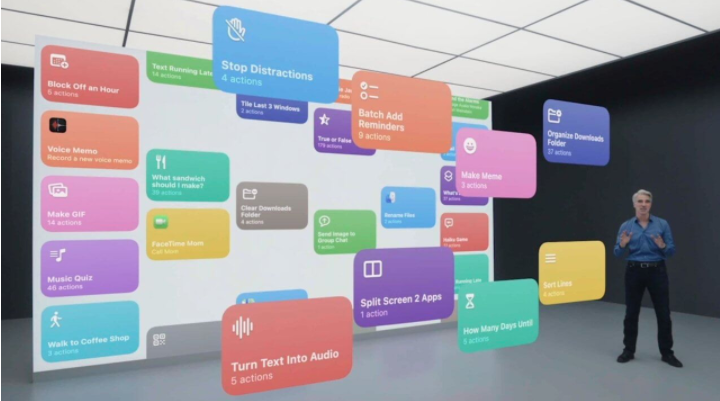Why do you need the Commands app on macOS?
Everything is clear with mobile devices. Millions of people have used Teams for a long time on iPhone and iPad. This was not always the case, at first, few people understood what it was, and they were in no hurry to try it. Application examples (creating a playlist with one-touch or organizing ski rides in the mountains) did not inspire everyone. And then the Apple support service clearly and intelligibly explained to whom and for what all these Commands may be needed. After that, more and more people used the Teams app. These features will also appear in macOS this fall. With rare exceptions, these recommendations are unlikely to be of interest to Mac users, although the general idea is understandable.
Macs, even MacBooks, are more stationary than iPhones and iPads. If Mac is used on the go, then few and rarely enough. And Commands in macOS are even more useful and useful. They cannot but differ from their counterparts for iOS and iPadOS. The beta version of macOS Monterey is already available from developers registered with the Apple Developer Program. The differences between the macOS implementation are still unknown.
How to use the Commands app on Mac
Teams are good for everyone. For example, for journalists, researchers, analysts, and the like. In most cases, the initial data exist in the form of documents from different programs. They have to be manually copied and pasted into the text being developed. Tedious and uncreative work. The data may require additional processing. If this routine has to be repeated over and over again, it’s just a disaster. With the help of Automator (which I will talk about at the end of the article), all this was greatly simplified. Speed up, reduce the likelihood of errors, not be distracted by secondary problems. The Teams application has the same tasks. If he found the case, his quick command must find the necessary data, import it, reformat it if necessary, and insert it into the text (for subsequent editing, but in the same program).
This logic is natural for fast commands, but for an application working with the right data to play these games, it needs a bit more. Quick commands (scripts) are made up of entities called “actions.” The basic set of Commands includes a rather large set of them. The actions from specific applications are imported into the action catalog – this is the job of the application developers. Will they deal with them? As long as they are popular and interesting to users, they will definitely be.
There are two types of Commands application scripts: “shortcuts”, which are run by the user, and “automation”, which are run automatically when a trigger is fired. Triggers of different types are triggered at a certain point in time when the battery charge reaches a predetermined limit or depending on the geolocation of the device. Perhaps in macOS Monterey (macOS 12), the nomenclature of triggers will not be the same as in iOS and iPadOS – we’ll find out in the fall. Quick commands can be launched from the command gallery, and you can also configure the way they are launched and applied there. Shortcuts to shortcuts can be placed in the Finder, in the dock, on the menu bar, in the Spotlight search engine. In addition, a quick command can be associated with a passphrase, in response to which Siri will launch it.
Why do we need Automator now?
macOS includes the Automator application, which is similar in its tasks and principles of operation. It has been on macOS since April 2005. Automator is almost in no way inferior to the Teams, and in some ways even surpasses them. It is more flexible, based on open source technologies, actions for Automator could be developed in Xcode. In 2005, great hopes were pinned on him. Enthusiasts were delighted with him, but he did not catch the general public.
But in the last 10-15 years, Automator and the technologies on which it is based have received little attention. Apple had no time for this: the move to Intel, iPhone, iPad, Apple Watch, Swift, and Automator was outdated. Hopelessly. Many dreamed that Automator would come to iOS someday. It turned out exactly the opposite: technology similar to Automator came to macOS from iOS and iPadOS. Thousands, maybe tens of thousands use Automator even now. At the peak of its popularity, the number of those using it did not exceed one hundred thousand. The teams have won the hearts of millions of iOS and iPadOS users in just three years. Actions from Automator can still be imported into Commands, and macOS Monterey is promised Automator support. But sooner or later it seems to be removed.

